Erik ten Hag’s Ajax has been one of the biggest entertainers in football Europe lately. In fact, they have embraced my heart over the last couple of years. With its pressing intensity, one-twos, quick short passes and manipulation of space to dominate the opposition team, Erik ten Hag has built a Dutch team that can compete against the best teams in Europe. Some would even say they have taken up the reign from the Tiki-Taka style of play used by Pep Guardiola’ Barcelona and the Dutch Total Football, and modernized it.
By combining the German school of Gegenpressing with elements from Johan Cruyff’s football philosophy and the Dutch Total Football, Erik ten Hag have implemented a unique vertical tiki-taka style of play that dominates the opposition by exploiting overloads and interchange of positions.
It’s been attacking football at its best! Both entertaining to watch with its many goals, and brilliantly tactically executed from a coaching perspective by adhering to the rules of positional play!
Erik ten Hags Ajax Tactics is one I’ve wanted to recreate in Football Manager for a long time, but I’ve prioritized differently. Until now!
The time has finally come to give you my Football Manager 2022 Erik ten Hag’s Ajax tactics and look closer to the successful 4-3-3/4-2-3-1 system deployed at AFC Ajax under Erik ten Hag by analyzing their tactics for Football Manager 2022. Along with this Ajax tactical analysis, you’ll get the chance to download a megapack of Passion4FM’s FM22 Ajax tactics featuring the 4-3-3 and Ajax’s 4-2-3-1 system!
Download Football Manager 2022 Erik ten Hag’s Ajax tactics
Get Passion4FM’s Football Manager 2022 Ajax tactics, that replicates Erik ten Hag’s Ajax tactics of 2021-2022 season. Experience Ajax’s unique vertical Tiki-Taka football build on possession, beautiful movements and intense pressing intensity to control and dominate matches in Football Manager 2022!
Megapack includes Ajax 4-3-3 and 4-2-3-1 system plus a few other 4-2-3-1 variants
Table of Content
Erik ten Hag’s Ajax Stats 2021-2022
Erik Ten Hag is currently in the leading position to take up the job as Manchester United manager due to his ability to work wonders at Ajax over the past 5 years. With limited resources and continuously being forced to re-build the squad by incorporating young Dutch talents to replace those being poached by bigger clubs, he has done a phenomenal job making Ajax into one of the leading clubs in Europe.
This season, Ajax’s performance have led to some remarkable stats.
At the time of writing, Ajax is topping the Eredivisie four points ahead of PSV with five matches yet to be played. They have roller coasted the Eredivisie this season by scoring 83 goals in 28 matches by winning 23 matches, and having 3 draws and losses in their records. So far, Ajax have managed to win 5-0 on 8 occasions – beating PSV on home soil as one of the biggest achievements to date!
By taking 20.7 shots per game, they have managed to score an outstanding 2.93 goals per game in the current season. Despite of that, their 15 goals against is even more remarkable! By conceding only 0.51 goals per game, the similarities to this Ajax side to Barcelona 2009-2010 is striking. Back then, Barcelona conceded 0.6 goals per game and scored 2.57.
Like Pep Guardiola’s Barcelona, Ajax is the master of keeping possession. With an average possession of 62.7% and 638.4 passes completed per game at 84.8 pass completion percentage they have literally dominated any opposition by keeping possession by using quick-short passes to work their way into goalscoring opportunities.
Ajax’s unique playing style and attacking fluidity has seen Erik ten Hag’s Ajax has scored 575 goals in 209 games, only conceding 176 goals. That’s a remarkable 2.75 goals per game with a little as 0.84 goals conceded per game. All in all, it gives us an amazing win ratio of 74.16%!
DID YOU KNOW?
Erik ten Hag needed only 128 matches to enter the history books as the fastest manager in the league history to reach 100 wins with Ajax.
It’s no reason why Erik ten Hag is the favorite for the Manchester United job! So let’s take a closer look at what The Red Devils Fans can expect by looking closer at how Erik ten Hag likes to set up his team and how we can emulate the Ajax tactics in Football Manager 2022.
Keep reading about my tactical analysis of Erik ten Hag’s Ajax tactics and the principles of play used by Erik ten Hag that works so wonderful for de Godenzonen.
Tactical Analysis of Erik ten Hag’s Ajax Tactics
The Playing Style of Erik Ten Hag’s Ajax
Erik ten Hag’s Ajax looks like a mix of Pep Guardiola’s Bayern Münich team and Jürgen Klopp’s Liverpool in the way they behave on and off the ball. By combining the best of Liverpool’s counter-pressing with the possession-hungry Pep’s Barcelona side, Ajax has impressed Europe with its magnificent style of play!
Erik ten Hag has created a fluid attacking system that is as balanced with the ball as without it. The team moves as one unit. It’s a perfect combination of compactness, triangles and perfect shapes on and off the ball.
All in all, it combines the best of two worlds: total control in possession and high pressing. Hard to break down for the opposition team in possession and hard to defend against out of possession.
Their gegenpressing combined with a priority to attack at greater tempo and more directly, have resulted in a unique vertical Tiki-Taka playing style that dominates any opposition. Aided by their structure and positioning in relationship to each other, it provides the perfect foundation for extreme domination of play.
By combining specific passing patterns and the focus on increasing the number of passing options for the player on the ball with aggressive press and looking to win possession as high up the pitch as possible, Ajax manage to dominate the match both in possession of the ball, in transition and off the ball.
A Quick summary of Erik ten Hag’s principles of play
- Playing to entertain and daring to play their type of game regardless of the opponent,
- intense pressing and giving the opponent as little time on the ball as possible
- movements and third man runs to create pockets of space to advance play effectively. These penetrating runs are difficult to defend against as they are often opposite of each other
- by interchanging positions they look to ensure constant occupation of spaces to link play perfectly to progress the ball through the half-spaces.
- defensive solidity through great organization and compactness when out of possession
- playing attacking football in a unique style that is as entertaining to watch as fun to play
- individual skills (flair and vision) to turn the result in their favor along with the technical abilities in possession of the ball.
All in all, Ajax’s tactics DNA and football philosophy can only be described as Total Football 2.0!
Ajax’s Formation & Shape
At Ajax, ten Hag has favored to set up his team in a flexible 4-2-3-1 formation. At least on paper. The starting shape with a double pivot in the middle looks more like a 4-3-3 in practice.
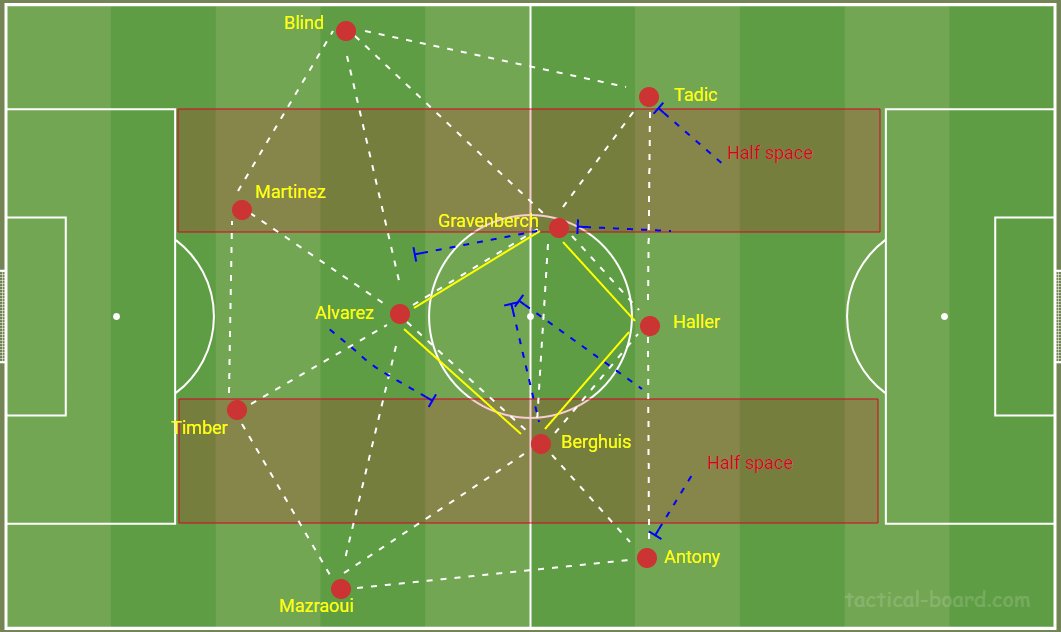
Even though formations is just numbers for Erik ten Hag, we can split this season up in two. At the start of the 2021-2022 season, he set up his team in a fluid 4-2-3-1 formation with a double pivot who splits.
Meanwhile Edson Alvarez holds position in front of the two centre-backs and covers the larger area in front of the defence, Ryan Gravenberch is given the freedom to join the attacks and take up advanced positions as play enters middle third – moving into the channels on the left side trying to overload the left half space.

The role of Gravenberch is highly important to the teams structure. His duty is to balance the midfield and connect the defensive unit with the attacking unit. At the same time, he’s a press-resistant player who can make progressive carries and look to both cause havoc in the oppositions defensive organization by dribbling forward with the ball, and give his forwards time to recover in their correct positions.
Gravenberch is the one often initiates counter-attacking moves. When progressing forward with the ball, Gravenberch will tend to move into central areas whilst the front four stretches play by covering each channel on the pitch. In these situations, the Ajax shape will look like a 2-3-1-4.

As a box to box midfielder, it makes him better connected with Dusan Tadic (left winger) and Steven Berghuis (attacking midfielder) and more able to utilize his creativity and ability to progress play into the final third by carries – something that attracts the attention of the opposition and free up space for Tadic, Haller or Berghuis to run into.

Actually, Ryan Gravenberch’s role in the system has seen a minor evolution from the 2020-2021 season. From playing in a deeper role, more like a Segundo Volante, he’s now playing more like an Advanced Playmaker, Central Midfielder support or Box to Box Midfielder in their 4-2-3-1 system.
Essentially, it’s the defensive stability Edson Alvarez provides, that lets Gravenberch now play to his strengths further up the pitch – using spatial awareness, magnificent Paul Pogba-ish flair with the ball and excellence touch and vision to control the ball in congested space. By having Blind tucking inside behind him also free up the defensive responsibilities of Gravenberch. He doesn’t need to drop as deep to be involved with the build-up.
If we combine the overall heat maps of Berghuis, Alvarez and Gravenberch, we see their positions are very asymmetrical. Everyone has different duties and roles within the system.

On the right, Steven Berghuis will make somehow similar movements as Gravenberch – moving into channels. As an attacking midfielder he will move from his starting position in the center towards the right flank. By trying to overload on the right half space, Berghuis is able to play progressive passes into the penalty box to set up either Haller or Antony for a goal scoring opportunity, or get into goalscoring positions himself by attacking movements into space.
NB! What’s important to remark is that when the team is in possession, Gravenberch and Berghuis will often make opposite runs of each other. They are very coordinate with their play.
As play enters the final third, the forward runs of Steven Berghuis on the right side of the pitch, alongside the forward runs of either Gravenberch between the channels or Blind overlapping on the left of Tadic, creates a 2-3-5 formation. This creates a numerical superiority against the traditional back four defense. If facing a back five, the duty of Gravenberch and frequency of his forward runs can increase, making it to six players getting into positions in or around the penalty area, since you got Mazraoui who tends to underlap and make progressive runs into the left half space – moving between the oppositions fullback and central defender just like an complete wingback.
Since Gravenberch and Berghuis moves into the channels on either side of Haller with Tadic and Antony stretching play, the shape of Ajax tends to look like a 3-2-5 in possession.

Up front, Ajax uses a traditional target man. While Erik ten Hag have previously used a more unorthodox striker (False 9 or deep-lying forward), the introduction of Sebastian Haller meant Ajax had different strategies to lean on. With Sebastian Haller they now had a more direct route to goal. Besides providing more depth to the team’s structure, it gave Ajax more options when entering the final third.
DID YOU KNOW?
Gravenberch and Mazraoui is the ones in this Ajax team who makes the most progressive carries into the final third. Gravenberchs 24 carries into the final third is joint with Benzema, 1 off Cancelo and 10 off Lionel Messi.
The Wingbacks Importance & the Back Three
In possession, Ajax uses a number of variants to maintain security at the back. When the two wingbacks overlaps on either side the defensive organization is a 2-1 shape. In these situations, Alvarez holds back and protects the area just in front of the two center backs. At times, his role will resemble a deep-lying playmaker defend, half-back or a defensive midfielder.
Then you have situations where Ajax forms a 3-1 defense with a back three of Lisandro Martinez, Jürrien Timber / Perr Schuurs and Danny Blind with Alvarez in front. This is often the case when Ajax uses their 4-2-3-1 system.
However, when Ajax uses their 4-3-3 system and are attacking, they favor to use a 3-2 base to protect against quick counters and to maintain ideal circumstances to recycle possession. Now, both Alvarez and Mazraoui (as Inverted wingback) will be positioned in front of the back three – protecting the center and the left half space channel.
In both of these situations, Blind tucks inside and sits narrower to both protect against breaks and to maintain the right body shape and angle to maintain a good passing lane to the wide channel.
By having one of the wingbacks tucking inside as inverted wingbacks by holding position inside the left half space when the team is in possession, it allows for more forward runs and higher mentality of both Ryan Gravenberch and Steven Berghuis. Both players can sit in the hole as 10s, while the wingers will stay high and wide – very similar to the structures of Johan Cruyff’s 3-4-3 formation in possession.
The roles of the two wingbacks is highly important to Ajax structure in possession. Against Borussia Dortmund in October 2021, Danny Blind and Noussair Mazraoui played high and wide – tasked to create overloads down the flank. Their positioning meant that the wingers could tuck inside into the half space channels and stay more connected with the striker.
This created three distinct triangles in their pass map – on the left (Tadic – AML, Gravenberch – MCL and Blind – DL), on the right (Antony – AMR, Steven Berghuis – AMC and Mazraoui – DR), and at the back (Lisandro Martinez (DCL), Edson Alvarez (DM) and Jürrien Timber (DCR)).
Then, there have been times the two fullbacks plays more similar to the inverted wingback. By tucking inside and holding position in the half space channel when the team is in possession, it’s important that the two wingers maintains width. Their likeliness to hold back, move inside closer to the center or stay wide to stretch play often became decisive for the positional rotation in the team. Basically, it determines the positioning of the central/attacking midfielders and the wingers.
Ajax’s 4-3-3 System
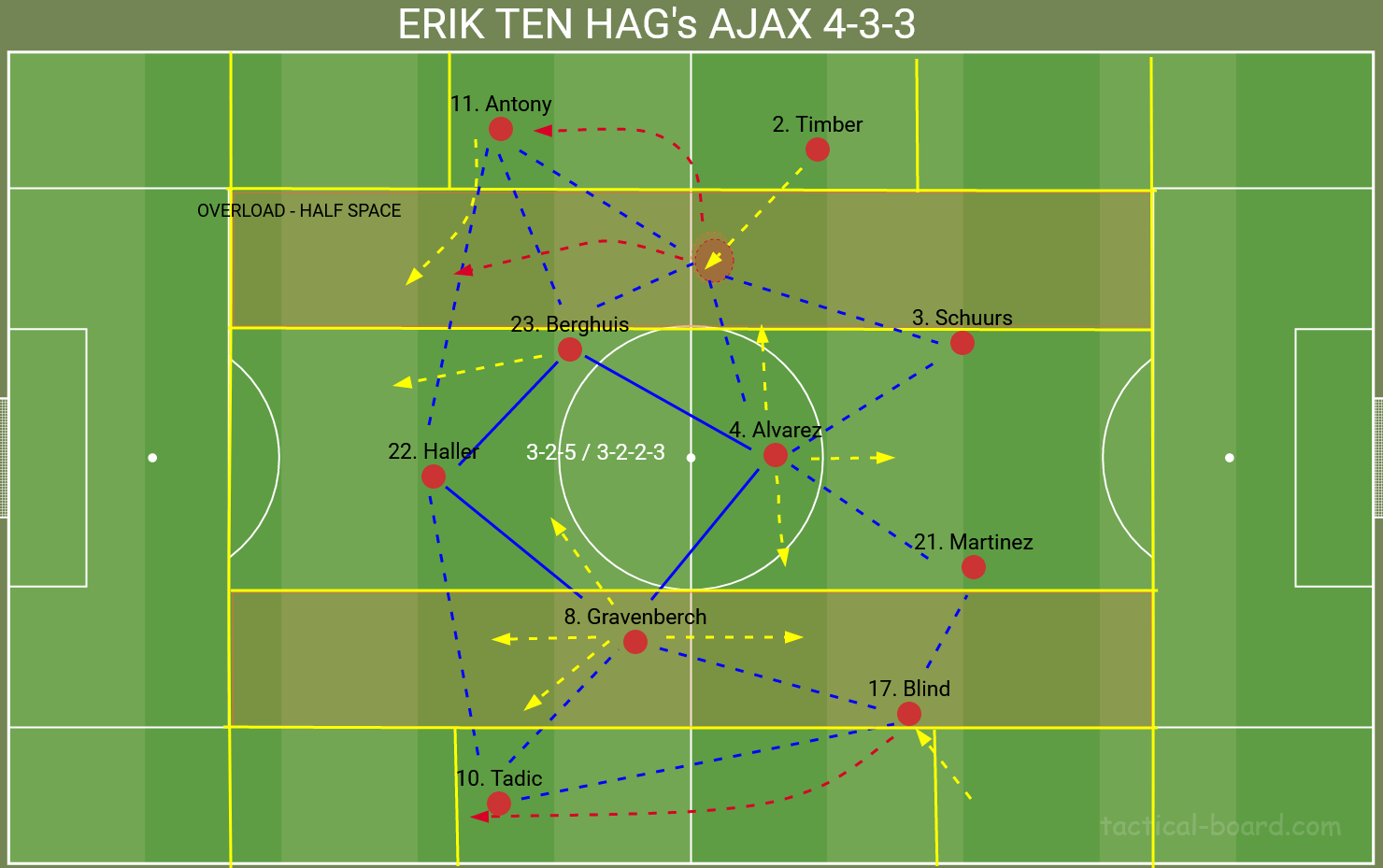
After the winter break, Erik ten Hag started to use his preferred formation – a modern 4-3-3 formation more often. Here, Edson Alvarez is a single pivot who protects the area in front of the defence. This gives more freedom to Ryan Gravenberch who can hold a higher position and look to overload the left half space together with Dusan Tadic and Danny Blind.
In the 4-3-3 system, the role of Ryan Gravenberch shifts from an orthodox box to box midfielder (MCL) or a segundo volante (DMLC) to a Mezzala or central midfielder. He doesn’t need to track back as often as Danny Blind since he will cover the initial area of his starting position in the 4-2-3-1 system.
The attacking midfielder (Steven Berghuis or Davy Klaassen) becomes an attacking central midfielder, meanwhile Mazraoui plays more like an inverted wingback than a complete wingback. Often looking to overload and protect the right half space for counters and offering the chance to underlap between Berghuis and Antony.
One of the benefits with the inverted wingback is that it improves the angles for combination play. It becomes even more difficult to defend against Ajax, as they creates numerical superiority both on the left and right flank.
In possession, the 4-3-3 system change to a 2-3-2-3 or 3-4-3 depending on the location of the ball and the interchanging of position. In fact, Ajax uses a number of different variations in their structure when in possession. I’ve seen they have used everything from a 3-3-1-3 to a 3-2-5 shape in attacking phase.
The movement and positioning of Ryan Gravenberch, Edson Alvarez, Steven Berghuis together with the right inverted wingback creates a 3-4-3 shape in the build-up phase.
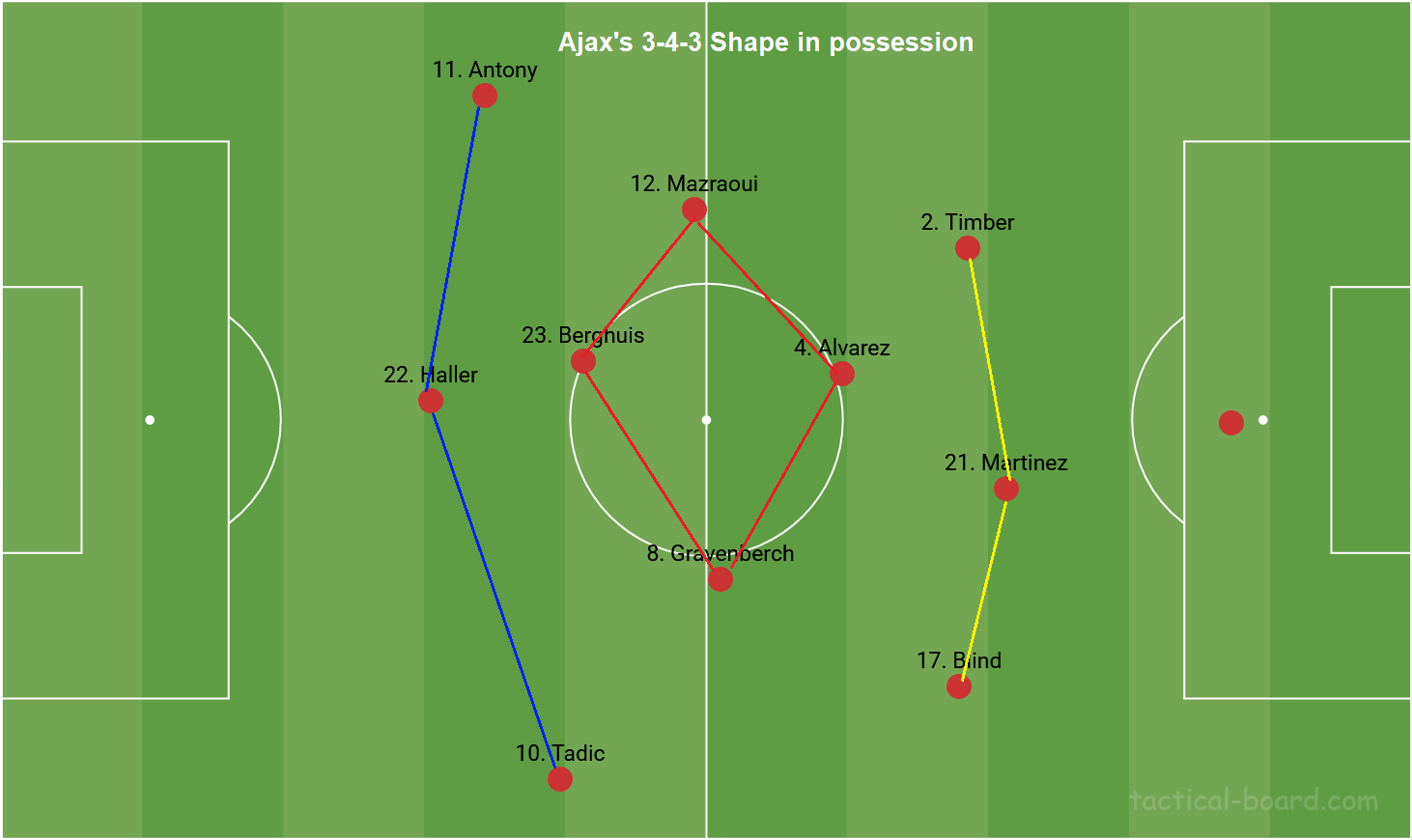
Over the next chapters, I’ll look closer to the Ajax tactics 2021-2022 and the principles of play Erik ten Hag favors for his sides.
Playing Out from the back
Like any other possession-oriented teams, Ajax wish to play out from the back. Playing out from the back requires defenders with great passing and technique. Both Alvarez, Blind, Martinez and Timber got great ball control and first touch to keep control of the ball despite under pressure.
Erik ten Hag’s Ajax tends to use different variants of building up play from the defence depending on whether the opposition press high or low – defends wide or narrow. Overall, their structure when building out from the back is very much like a 2-3-2-3 – much similar to Pep Guardiola’s Barcelona or what you’ll get from a traditional 4-3-3 formation when playing out of defence.
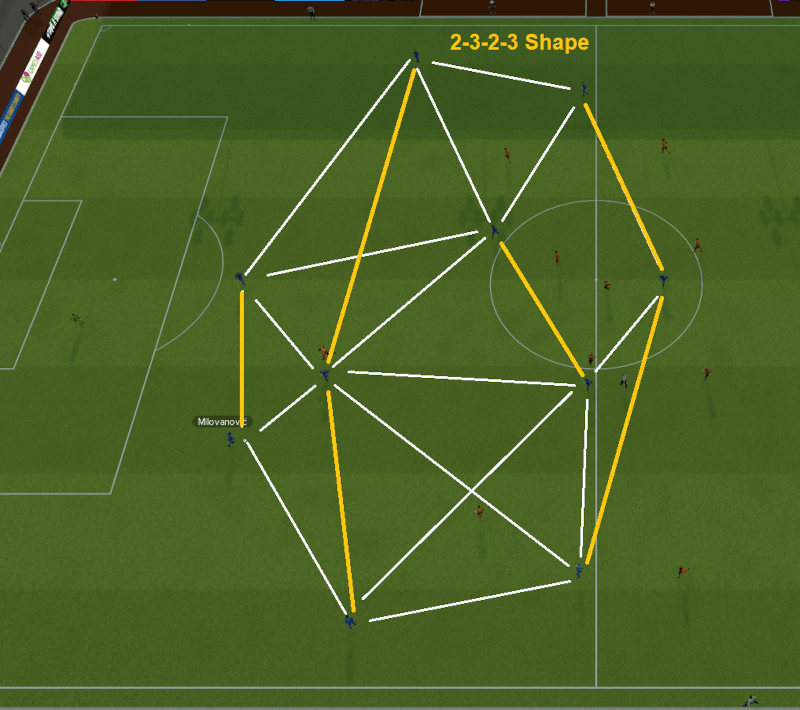
When the goalkeeper (Pasveer/Onana) is on the ball, Alvarez will drop deep between the two center backs, or maintain a high position inside the center channel forming a 2-1 shape. Timber and Martinez will move to either side of the goalkeeper – forming a passing triangle with him, while the wingbacks will push up high and wide. By stretching the play, it aims to open up the center of the pitch making it more difficult for the opposition to close down and block passing lanes through the middle.
The wingers will maintain a wide position as well. Often, Antony will hold a similar line of Mazraoui. This to keep a quality passing lane to progress play if Mazraoui receives the ball, while Tadic is positioned more into the left half space and Berghuis and Gravenberch moves closer together in the center channel.
On the ball, the goalkeeper have several passing options:
- He can play directly to the fullbacks who can progress the ball directly down the flanks. Learn more in the section about Combination Play
- He can make short passes to one of the centre backs who can then make a decision to play more direct or look to retain possession and change the angle of attack – most often to Blind who then can utilize his vision and body shape to work the ball forward.
- Haller, the 190cm tall forward, gives the goalkeeper a direct route to goal. We’ve seen a number of times, if the opposition tries to high press that he tries long kicks to the target man. It’s very much like the sweeper keeper on support in Football Manager.
- He can also aim for one of the two wingers who tries to isolate their direct opponent.
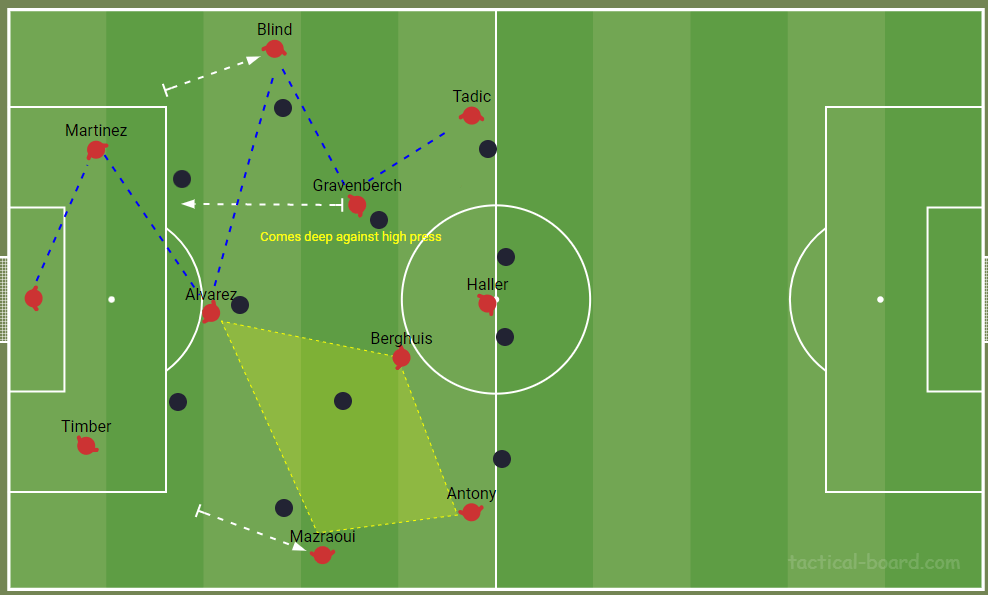
Ajax’s main aim when playing out from the back by quick short passes is clear.
One the one hand, they wish to make the opponent guess which build-up variant they will use by stretching the pitch as much as possible both in terms of depth and width to create space between the lines to progress play. The opposition must either take the tough decision of where they wish to concede space – in the middle or down the flanks. Most often, they will provide security to the center channel something that lets Ajax focus play down the flanks.
Secondly, Ajax focus on to create numerical superiority around the ball. Subtle movements like Blind first moving high and wide before dropping deep to receive the ball and create a 3-1 shape will outnumber the three forwards in a 4-3-3 formation. Then, if using two pivots, Gravenberch can occasionally drop deep to receive the ball to provide even more passing options against a high press.
When building out from back
Danny Blind is often the orchestra of attacking moves meanwhile Lisandro Martinez is often the heartbeat of build-up play. In possession of the ball, Blind makes the most frequent progressive passes, whilst Martinez tops the chart for number of touches.
While Blind often tends to look for progressive passes towards Tadic or Gravenberch, Timber looks for progressive passes to either Mazraoui in the half space, Berghuis in central areas or Antony out wide.
Actually, Antony is currently the player who have received the most progressive passes in Eredivisie for Ajax this season. With 11.89 progressive passes per 90 minutes, the number equals to Liverpool’s Mohamed Salah.
On the ball, Blind have several passing options. He can look to combine with Gravenberch to progress play quickly and efficiently into the final third, or make the occasionally switch of play towards the left wing to try to disrupt the opposition’s shape.

If Lisandro Martinez is on the ball, he can either progress the ball forward to Ryan Gravenberch who can then carry the ball with his feet into the final third or look for more advanced passes that goes directly to the Target Forward. At the same time, Gravenberch can also make one-two’s with Dusan Tadic or Danny Blind – making the team gain ground in a short space of time. The same scenario can be seen on the right flank between Mazraoui, Berghuis and Antony.
Regardless, the structure of the 4-3-3 system, or the 4-2-3-1 system, provides perfect circumstances for combination play due to the number of passing options, the ideal positioning of the players by maintaining shape and the movements of the players to improve the quality of the passing lanes.
Erik ten Hag’s 5 Principles of Play – Attacking Strategies
A. Recycle Possession Effectively
At the heart of the team’s playing identity you have a strong focus on keeping possession of the ball by moving the ball in intricate passing patterns.

At it’s most effective, Ajax is more decisive in possession than for instance the famous Pep’s Barcelona side. The teamwork and attacking fluidity of the team helps the players to create lovely one and two touch passing moves. Their pass and move style of play is simply astonishing to watch!
Instead of a slower build-up based on patiently waiting on the right moment to enter the final third, Erik ten Hag’s Ajax is a bit more direct. Rather than recycling possession at a low tempo like Pep Guardiola’s Barcelona and patiently awaits gaps to appear in the opponent’s structure, Ajax wish to progress the ball forward by exploiting openings in the opposition’s shape quicker and earlier.
At their best they can score goals, or create major chances after as few as 5 to 6 moves – showcasing how to zig-zag the ball in perfectly executed combination play by exchanging passes at a higher tempo to lure the opponent.
Like Manchester City, they use passes to move their opponent. With quick flicks, one-two’s and short passes made in quick tempo, they want to get the ball between the lines, into the channels and behind their opponent.
Ajax’s Passing Stats
Like Pep Guardiola’s Barcelona, Ajax is the master of keeping possession. With an average possession of 62.7% and 638.4 passes completed per game at 84.8 pass completion percentage they have literally dominated any opposition by keeping possession by using quick-short passes to work their way into goalscoring opportunities. They have made the most key passes in the Eredivisie and is capable of creating chances from all over the pitch.
[image Eredivisie most average passes]
In the Champions League, no other have made more progressive passes than Danny Blind (69). Behind him you have Lisandro Martinez (63) while the next Ajax player on the list is found on 8th place with 47 progressive passes (Nassouri Mazraoui).
These passing statistics could in fact resemble some of the best Pep Guardiola sides.
To achieve such passing stats, the positioning and movements off the ball is key! It’s teamwork at its highest level!
B. The Importance of Positional Play
With a fluid attacking system, Erik ten Hag have lent ideas from Johan Cruyff’s, Rinus Michel’s Total Football and Pep Guardiola’s principles of positional play to create a balanced system that helps to overload the opposition with movements and off the ball runs into multiple channels to break down the opposition team’s defensive organization in possession, whilst being compact and defensive solid to regain possession quicker and higher up the pitch.
By adhering to the principles of positional play, Erik ten Hag’s system focuses on creating numerous triangles and diamonds for the player with the ball along with numerical superiority around the ball zone. Players help each other to create better angles to pass the ball, as well as providing defensive solidity if play breaks down, by their positioning and focus on adding a spare man around the ball zone to build up fast and more vertically.
Everyone knows where to run and be, and when to do so, depending on the location of the ball and the movements of their teammates. Everyone understands how to provide cover for each others movements to remain a similar structure and shape.
For instance, if Timber brings the ball out of defence by carrying the ball forward, Edson Alvarez will drop deep to maintain a covering role. If Mazraoui overlaps on the right flank and provide the width, Antony will move inside, or if Blind moves inside, Gravenberch will move wide. The same can apply all over the pitch as players interchange positions to create passing triangles.
Positional play works to enable teams to progress the ball forwards through the creation of triangles or diamonds that give the ball-carrier space and several passing options at any given time. Then, by drawing an opponent towards the ball, a player will free up a teammate elsewhere to receive the next pass.
The Coaches Voice
As the principles of positional play dictates, player’s positioning and movement must follow strict rules – all depending on the location of the ball on the pitch. With different rules and strategies depending on which zones on the pitch the ball enters, players have the freedom to move and rotate positions within a specific framework dictated by the manager’s desire.
To quickly recap the concept of positional play, there can never be more than three players on a horizontal line or two players down a vertical lane. This means that there can never be more than two players in the wide channel, down the half space or centre channel at all times.
This means that regardless of who moves where, there are restrictions. All zones must be occupied by a player, whether we’re talking about the lanes between the lines or the five channels across the pitch. This requires great understanding of each others role and positioning within the framework and what’s makes positional play so difficult to adopt.
… to get your team to function… There are so many aspects you need to train over and over again. It takes time to find the right balance.”
Erik ten Hag
The understanding of space and the focus on maintaining a good balance within the structure is one of the keys to effective combination play and why positional play is favored.
If applied perfectly, there will be multiple players around the ball zone with a number of players in a perfect angle to play that pass and move type of football that has seen Ajax carving through the lines of the opposition in such an effective manner – moving the ball further into a more dangerous zone on the pitch in a decisive manner.
Time and time again, we’ve seen players having as many as five passing options or routes to goal. Often different opportunities, different attacking strategies that means the opposition team have to guess Ajax’s next attacking move, and where they will penetrate.
Aided by taking advantage of the concepts of positional play, Erik ten Hag’s Ajax manage to both keep possession effectively and open the opposition’s defensive structure with passes and movements.
Let us now take a closer look at how Ajax attack their opponent by looking further at some of the attacking principles Erik ten Hag has applied at Ajax.
It’s the movement of the players and their interchanging of position that lets Ajax progress the ball quickly and effectively up the pitch.
C. Third Man Runs & Decoy Movements
The interchanging of positions by constantly looking to create triangles and diamonds aims not only to increase the number of passing options for the player with the ball. Also, it aims to disrupt the organization of the opposition’s defensive structure by off-the-ball runs.
By combining numerical advantages with positional superiority and qualitative superiority, Erik ten Hag’s intention is to create space to attack in by freeing up space in specific zones depending on the ball location.
The focus on third man runs is one of the mandatory principles of Erik ten Hag’s Ajax. Even though the team defends and attacks as a coherent unit, the team needs off-the-ball runs to free up passing lanes and create space, especially centrally and between the lines.
In order to destroy the opponent, you need off the ball runs! That’s the key to success!
Erik ten Hag
What they will often do is to stack up players on one side – creating overloads and numerical superiority around the ball zone before having a player running into space on the opposite side of the playing area. It could be combination play on the left flank with Blind, Gravenberch and Tadic exchanging passes before Berghuis moving diagonally into center – attacking the space left behind Gravenberch.
The scenario is often a back pass to a player in support who makes a defensive splitting pass to a breaking player. The aim with these supporting passes is to ensure the closest marker pushes out of his line to press the player on the ball – something that leaves space behind.
By using lay offs and cut backs, Ajax wish to draw opposite markers out of their position which they eventually can attack in. The exchanges of passes serves a particular purpose – to create space to attack in!
That’s why they wish to create these triangles. Basically, you’ll have three players attracting attention with their short passes while a fourth player making a run behind which the player in the bottom of the triangle can make a diagonal through ball / progressive pass onto.
In the end, these runs will cause chaos, and they will disrupt their organization!
D. Playing between the lines
To lure the opponent, and create space, Erik ten Hag wish to apply, what he refers to as creating several 10’s. The team aims to set up Steven Berghuis and Ryan Gravenberch between the lines. Their off the ball task is to offer the team an opportunity to progress play into the final third by making third man runs, carries and thread passes to the more attacking-minded players; Antony, Dusan Tadic and Sebastian Haller.
Their spatial awareness and especially Gravenberch’s importance to the team to offer passing options further up the pitch – connecting the defensive and attacking unit is of utmost importance.
Often we see both Gravenberch and Berghuis trying to position themselves between the lines when the team builds up play. From their more central position, they look to make either underlaps between the central defender and the fullback – trying to move behind the back of the man pressing the ball, or move towards the center running diagonally behind the striker.
What you’ll often see is that both Berghuis and Gravenberch makes opposite runs of eachother. If one underlaps and moves diagonally towards the flank, the other moves centrally.
These runs have two purposes.
At the one hand, they shall try to disrupt the defensive organization of the opposition by causing chaos. In practice, Ajax looks to take advantage of positional superiority with these runs. As they move forward and make runs into space, they will create numerical superiority in that area – giving an opportunity for the player with the ball to either make a quick pass into space or take advantage of the space opened up in the center to cut inside or cross towards the center.
At the other hand, it could be seen as a decoy run: a run with the only purpose to attract the closest markers attention and drag him away from zone 14 (the area where most dangerous chances are created). The result of these opposite runs is that they help each other to get space to receive the ball.
At the same time, their runs can also be aided by attacking runs from deeper positions, whether it’s Blind moving inside or Mazraoui underlapping whilst Berghuis or Gravenberch moves wide.
One of the biggest advantages of these third man runs and focus on making underlaps is to basically free up space elsewhere on the pitch – whether that means more time for the player on the ball to pick out dangerous passes or create space for another player to receive in a more dangerous position.
Actually, by holding position between the lines, they become a great base for attacking play. Instead of underlapping they can benefit from their positions by making key passes and through balls towards Tadic, Haller or Antony due to how they create the base of an triangle on each flank. This takes into account the wingbacks overlaps on the flanks while the wingers tucks inside.
At the same time, it maintains the desire to play pass and move football by working the ball through the lines of the opposition as passing triangles and perfect angles are maintained via great body shape and positioning.
Focus of Play
The focus on creating triangles and diamonds to increase the number of passing options for the player with the ball is only one of the keys to Ajax’s success.
A major contributor to the success at Ajax is how the team manage to provide a perfect balance between width, depth and compactness both in and out of possession.
The mandatory focus for Erik ten Hag’s Ajax in possession is to exploit overloads, often down the wide channels and through the half spaces.
Ajax favors to focus play down the flanks. The left flank is often used for combination play and create overloads. Often Gravenberch moves to the left to create 3vs2 situations, while the overlapping runs of Blind creates 2vs1 against the opposite fullback.

On the right, they try to use isolation’s to dominate the opposition by setting up Antony for one-on-one situations. This concept is referred to as qualitative superiority regarding positional play. The idea is that you have a player that is better than his direct opponent and isolates them in an one-on-one situation.
E. Stretching the Pitch: Overloading vs Underloading
According to the principles of positional play, Ajax wish to create as much space as possible in the center of the park to aid ball circulation by stretching the pitch as much as possible. The players will look to try to open up passing lanes for each other with their positioning.
In the Ajax system wingers look to stretch the opposition laterally by staying wider – close to the touchline.

This strategy is used to make it more difficult for the opponent to cover all passing options on the pitch. If the opponent stays narrow and tries to avoid passes into the central areas of the pitch, Ajax got direct passing options to the flanks. Similarly, if the opposition tries to cut off the passing lanes to the wide players, there will be space between the channels to move the ball into.
At the same time, by instructing the wingers to provide the width, it will create advantagous 1v1 situations in wide areas as they try to isolate one of the defenders via movements in the half-spaces.
The positioning of Danny Blind (left) and Noussair Mazraoui will often decide the positioning of the wide players and movements of the midfielders. If they moves inside into the half space to free up the passing lane to the wide player (Dusan Tadic or Antony), either Gravenberch or Berghuis must move towards the center to draw attention away from play, or make progressive runs . Then, the positioning of the wingbacks, whether they invert (underlap) or move wide (overlap) will depend on who is in possession of the ball, in which zone the ball is in and the movements and positioning of other teammates close by.
Although Ajax’s desire is to play out from the back using short simple passes, they are no strangers to making direct passes over a greater distance forward. When the central defenders or the wingbacks is in possession of the ball, they have several options.
When Blind (left) or Mazraoui (right) is on the ball, they often tend to make progressive passes to Dusan Tadic (left wing) or Antony (right wing). Even, Martinez or Timber can look for passes to the wide players.
To do it successfully, it’s important that the two central midfielders free up passing lanes to the wingers – dragging the attention of the opponent in to the center. At the same time, the wingback on the opposite flank will move inside the half-space, just like an inverted wingback, while the wingback closest to the ball zone will drop deep to receive the ball to ensure he can progress the ball out wide.
However, on the opposite flank, the positioning of the wingback in the half-space channel will aim to better the quality of the passing lane to the winger – helping the team to progress the ball into the final third quicker and earlier.
Actually, they are pretty brilliant at unbalancing the oppositions team with movements and rotations, and using change of tempo both in passing directness and speed of exchanging passes to attack the opponent.
The concept of Stressbringers
When Ajax is in possession, the two wingers, Dusan Tadic and Antony will stay wider, almost hugging the touchline. Whether the team is playing out of defence or the ball advances into the final third, at least one of the wingers will stretch play.
Their duty to stretch play off the ball is highly important to the team’s attacking strategies. Erik ten Hag refers to them as “Stressbringers“. The initial aim with their wide positions is to try to stress the opponents out. The defender must have to keep an eye on both the ball, his marker and teammates positions as play enters his zone.

For instance, if play is located on the left flank, the right winger (Antony) will look to move away from where play is located. His positioning and movement is simply a decoy run to lure the opponent. The aim is to draw attention with his positioning – increasing the space between the channels and lines in the opposition’s defence.
It’s a perfect combination of overloading on one side while underloading on the other.
If the opponent shall have control of Antony’s future runs, he must keep him in his sight. That means positioning himself in an angle that spots his runs and is close enough to intercept his move.
If the opponent moves too much into the centre of the pitch, the winger will be free to receive the ball – either via diagonally passes where Ajax switches play quickly, or have the opportunity to make runs behind the player’s back to be the receiver of Ajax’s low crosses and through balls from zone 14.
“In most scenarios it isn’t the man on the ball who decides where the ball goes, but players without the ball. Their running actions determine the next pass.”
Johan Cruyff
It’s here the importance of the third man runs from the 10s or (8’s in the 4-3-3) comes to its force. By using positional superiority to get players between the lines or behind the opponent’s defensive line, they aim to force one of the defenders to move wide – creating space in the center for runs into channels from the attacking midfielder, or the box to box midfielder. All the time, the opposite defenders far from the ball must make a decision to either follow the movements of their teammates to contract space, or become isolated against the forward and/or the winger.
By letting Antony play to his strength and utilize his Dribbling, Flair, Acceleration and Agility against his direct opponent can quickly lead to a goalscoring opportunity.
If Antony receives a pass and comes up in an one-on-one-situation, he got several options to progress play. If the opposite marker has full control, then Antony can be aided by Mazraoui’s run and positioning, who tends to hold position inside the right half-space, but who also got the freedom to make underlaps or overlaps. Antony can either make a supporting pass to Mazraoui, or get help to overload on the right flank as these two players creates a 2vs1 situation.
Antony can also look for direct through balls and diagonal passes towards the center, where Berghuis moves into the channels behind the back of the direct opponent. Finally, he can try to beat his marker by either cutting inside or move towards the byline for a cross.
Crossing
We have now seen how Ajax uses overlaps, underlaps, movements between the lines and third man runs to manipulate space to come to goalscoring opportunities. Even though they favor to thread passes into the penalty box either to Haller or Berghuis who moves behind the opposition’s defensive line, one of their preferred attacking strategies is to take advantage of in-swinging crosses from wide positions.
A frequent strategy Ajax uses when entering the final third is to cross early into the box, often by Dusan Tadic or Danny Blind. These crosses aren’t merely coming from deep, but within the wider areas of the penalty box. As soon as the wide player is on the ball, he will without hesitation look to make either a hard low cross towards the center or an in-swinging cross.

Ajax often look to Dusan Tadics strengths in possession of the ball to unlock the opposition. The player tops the chart for the most key passes made (119), most assists (16) and most big chances created (26). The combination on the left wing often results in crosses from Dusan Tadic. So far, he’s made 247 crosses – something that makes him top the statistics there as well!
On the ball, the runs from Berghuis, Haller and Antony, along with the positioning of Gravenberch gives Tadic several options. He can make a cut back to Gravenberch, which looks to retain possession and better the angle for a through ball in the next stage.
Then, he got the option to make an in-swinging low cross towards the centre of the 6yard box, or a diagonal low cross towards the penalty spot where Berghuis often arrives. In these situations, the movements from Haller is important. He creates the space for Berghuis by dragging his marker away from target area.
That was the case when Berghuis scored one of the goals in Ajax’s 5-0 thrashing of PSV in October 2021. Then, Tadic played a hard, but accurate diagonal pass/cross towards the edge of the penalty box where Berghuis arrived to firing away a shot on goal.
However, Haller, who stands at 190cm, will of course be the main aim for a cross, as his jumping reach and physic in aerial situations will most likely beat his marker. So far, the former West Ham player have won 3.64 aerial situations per game in the Eredivisie, and 3.3 aerial duels won per game in the Champions League.
The attacking partnership between Tadic and Haller have resulted in 20 goals for Haller, where 5 of these were assisted by Tadic.
Decisiveness in the Final Third
What’s important to note, is Ajax decisiveness in the final third. In attacks, Ajax’s playing style differs quite alot to Pep Guardiola’s Barcelona Tiki Taka style of play. Rather than patiently await for gaps to penetrate in, Ajax favor to attack quickly and rapidly.
Once the ball enters the area around the penalty box it’s not uncommon to see the players taking an immediate shot on goal. Whether it’s a cross or a pass leading up to the situation, it doesn’t matter. It doesn’t even need to be a clear goalscoring opportunity. They prefers to fire it away, rather than play the ball from side to side. In fact, it looks more like they tend to ‘Shoot on Sight‘ to use a term we know from the team instruction in Football Manager, than working the ball into the box.
There are mainly two reasons why I believe Ajax prefers to shoot more often.
- To avoid loosing the ball in dangerous situations which can lead to quick counters. Despite having players in cover, their attacking intent provides a vulnerability against long balls forward and balls over the top which quick agile players can exploit
- The number of Ajax players inside the box provides opportunity to score from rebounds. Even if a shot is blocked, they got enough players to recover the possession of loose balls inside the 6 yard area.
PS! That’s not to say there have been cases where Ajax seemingly pass their way into the goal with quick short passes. All in all, it shows the number of strings Ajax have in their attacking vocabulary.
Erik ten Hag’s Ajax Out of Possession | Defensive Strategies
Defensive Structure
Out of possession, the defensive structure of the 4-2-3-1 remains rather similar. However, rather than the wingers staying wide and the double pivot split, they will stay much more compact and narrow. The narrow shape looks to avoid passes into the central, and will make the team defend very similar to a 4-4-2 – creating a box of 4 players in zone 14. This will outnumber the opponent, especially if they are playing with a 4-3-3 or a wide 4-2-3-1 formation.
Out of possession, Ajax is a fairly man-oriented team who wish to push constant pressure on the ball. It’s pressuring out of line to minimize the playing area. It’s not uncommon to see Ajax press with five players up front.
Often, Gravenberch tight mark the opposing midfielder or pushes up to compress the space behind the attacking line – making it more difficult for the opposing team to build out with ease. At the same time , Alvarez will tight mark the opposing attacking midfielder, while Berghuis tight marks their playmaker. Essentially, it’s a mix of blocking passing lanes and keeping control of their direct marker.
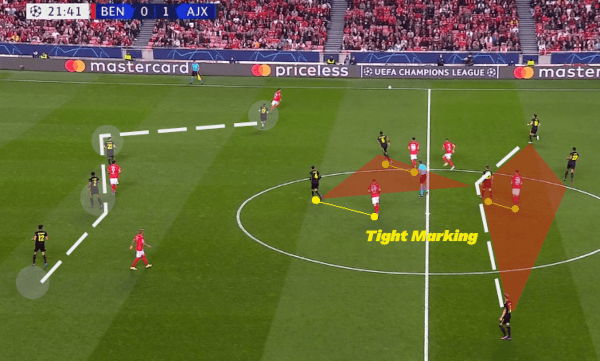
Against Borussia Dortmund, the defensive duty of Alvarez, meant the team defended in a low 4-5-1 block. In this situation, the defensive midfielder dropped between the two centre backs, almost like an half back.
However, in the 4-3-3 formation, Erik ten Hag favors to defend in a 4-1-4-1 structure, or a compact and narrow 4-3-3 shape that’s very similar to the defensive shape of Klopp’s Liverpool. When using their 4-3-3 narrow defensive shape, the wingers will tuck inside, the wingbacks will push up to support press and the midfielders will man-mark their direct opponents.
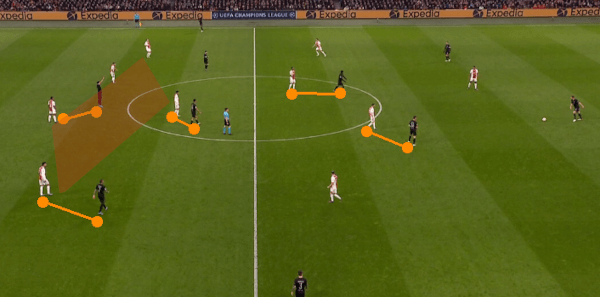
By remaining fairly compact in the center it will concede space in wide areas and invite the opposition team to play out wide and down the flanks.
Nevertheless, it gives a great foundation to put pressure on the wide areas as they can set up pressing traps. By using the touchline as an defensive approach, they look to decrease the playing area for the opposing fullbacks. With fewer likely passing options, the opposing teams attacking play will become more stagnated.
Intense High-Pressing
The extraordinary possession stats is aided by ten Hag’s desire to win possession as high up the pitch, and as quickly as possible. Through relentless pressing and swarming the opposition with an aggressive high press and a high defensive line, Ajax looks to disrupt the build-up of the opposition team by limiting the number of obvious passing options for the player with the ball forcing them to make more risky passes.
According to The Analyst, no other teams have had more shots on goal (11) after a high turnover than Ajax in the Champions League 2021-22, as of November 24th, 2021. Ajax’s pressing abilities has resulted in 8.2 in PPDA (passes played per defensive actions) making them into the third best club in Europe. This means that an average of 8.2 passes are played from the opposition before Ajax successfully regains possession. Topping the list are Liverpool (7.2) and Chelsea (7.5).
Often, we see two to three Ajax players closing down the space around the opponent on the ball, limiting his time and space to make clever forward passes, while the other teammates cover the defensive zones behind the press.
At Ajax, the forwards are the first line of defense. Their aggressiveness and acceleration to close down opposing players on the ball is essential in their desire to regain possession as close to the opposition’s penalty box as possible.
Haller, Berghuis, Tadic, Antony and even Mazraoui and Blind will push out from their position to chase loose balls, cut off passing options and put pressure on the ball carrier by closing down players much more often.
When the opposition goalkeeper is in possession of the ball, Ajax wish to force play to one side – normally towards the channel where Berghuis protects. In these circumstances, it’s all about closing down passing options for their opponents by sticking particular close to their direct opponent.
The task for the wingers at this stage is to shut off any passing angles towards the fullbacks meaning the opposition team must work hard for openings to play out of defence.
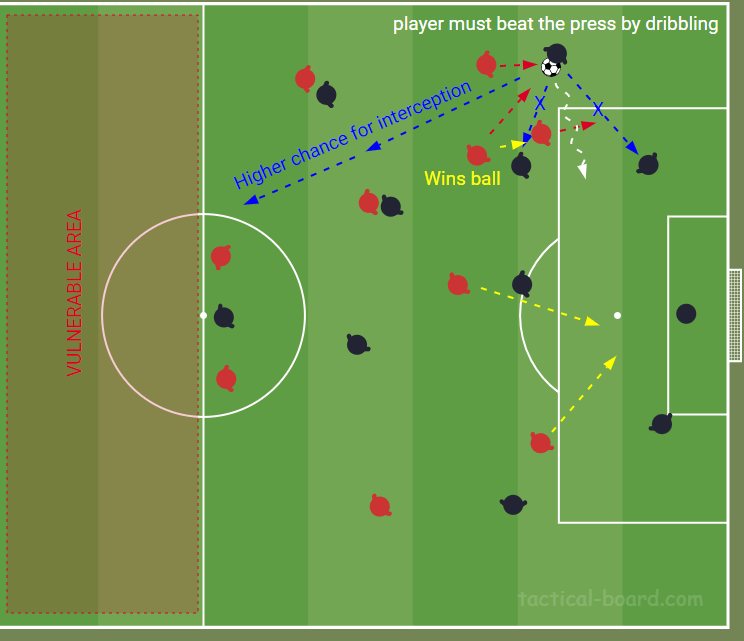
Essentially, Ajax tries to overload the opposition out of possession, as well! As this illustration shows, with a combination of tight marking and numerical superiority, Ajax forces the opponent to play sideways passes at the back or be more individualistic – making it easier to intercept passes that’s not 100% accurate both in strength and length, or carries towards the center.
According to the illustration above, there are none obvious passing options for the opposition team due to Ajax’s intense high pressing. The opponent could try to make a supporting pass to his central defender, but the forward runs forward to block off that option. He eventually decides to run with the ball inside, as Ajax’s winger forces the ball on his left foot (the opposite of his playing position). The attacking midfielder, who initially tight marks their defensive midfielder wins the ball by closing down as soon as he initiates the carry of ball.
Suddenly, Ajax have five players against the oppositions four. The inverted winger on the opposite flank is free to receive the ball, and with a quick movement so is the central player. With only a few passes, Ajax is clear on goal!
You can watch the full clip of this situation in this video.
The Art of Counter-Press
The key to counter-press effectively is compactness and great balance despite players will interchanging positions. By decreasing the space between the players, and playing much more narrow, it’s easier to regain possession in the next stage.
The positioning of the players is the key here. Since the structure remains rather similar despite how the players have interchanged positions before they re-group, their compactness and balance within the defensive/attacking structure means that the team can counter-press effectively. When possession is won, they can immediately restart their attack right away and try to counter-attack.
The result is that the transition periods between attack and defend is reduced – a strategy we have come to know from Pep Guardiola’s tactics. The team looks like it’s always in possession.
Ajax’s Vulnerabilities
Often, the opposition have to look for direct balls forward. This is one of the vulnerabilities with Ajax’s high defensive line and pressure on the ball. By conceding lots of space at the back they are fragile for balls over the top. It requires that the central defenders must be quick, have great awareness and is positioned correctly to intercept the forward runs by the opposing attacker by getting his body between him and the ball.
In Football Manager 2022, especially when coming up against teams who wish to play highly direct, trying to counter-attack by long balls over the defensive line it might be useful to lower the defensive line one to two touches: from ‘Very High’ to higher or Standard.
This is also a case if you’re playing against better teams, so you don’t risk them playing in behind you through a combination of quick passes, runs from quick players á la Mbappe or Mane.
DID YOU KNOW?
Ajax is the most disciplined team in the Eredivisie.This season, they have only received 27 yellow cards and 1 red card in 28 matches. At the same time, their numbers of interceptions and tackles won doesn’t stand out either. However, they manage to force the opposition to make mistakes by rushing their decisions. The loose balls will therefore be easier to intercept or take control of.
I’ve now given you a fairly detailed tactical analysis of Erik ten Hag’s Ajax tactics 2021-2022. In the next page(s) we’ll take a closer look at how I have tried to replicate Erik ten Hag’s Ajax tactics in Football Manager 2022!
PAGE 2 | FM22 Erik ten Hag’s Ajax Tactics: Total Football 2.0 Domination Explained







1 Comment
superb tactics impressive as analysis what are the improvements that it would be necessary to have for fm23